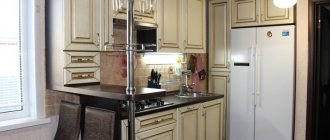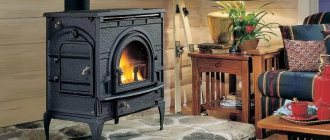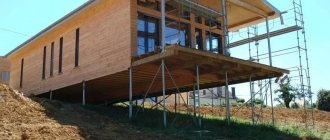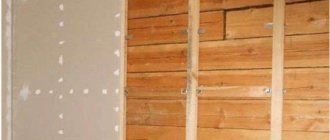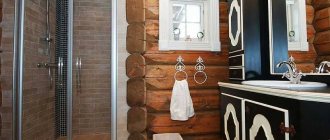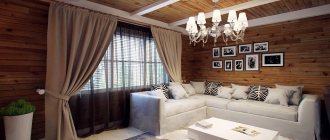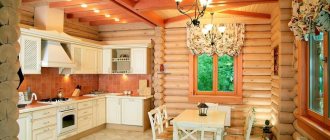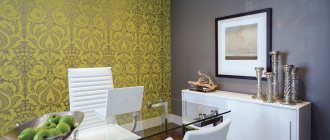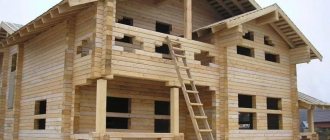Some builders are sure that the vestibule is a useless part of a private house, the heating of which wastes energy. In contrast to this opinion, most owners consider a vestibule for the home to be a useful invention, and prefer to equip their home with it. Let's figure out what functions this compact room performs, what it is like, and what materials are best used for cladding and interior design.
Entrance vestibule design Source katlavan.ru
Vestibule functions
Somewhere in the tropics, the layout of houses or cottages looks impressive and quite unusual to our eyes: from the front door you go straight into the living room. In our latitudes, such a situation is simply impossible to imagine, and the point is not at all in the lack of hospitality.
The layout of housing in temperate latitudes is greatly influenced by weather conditions. Anyone who has an idea of the changeable Russian climate can understand why a warm vestibule is needed in a private home. In autumn, winter (and sometimes in summer), cold air rushes through the open front door, and only the vestibule can stop the cold from spreading further throughout the house.
This is the main function of a compact room: it serves as a reliable buffer, protecting the comfort of the home from the vagaries of Mother Nature. In summer it saves from dampness and dust, in winter – from cold, additionally helping to save on heating.
Protection from winter cold Source ivd.ru
The vestibule is also convenient from a hygiene point of view - outerwear and outdoor shoes are stored in it. A sufficiently large extension has an additional advantage: it is convenient to store things for which there is no place in the house (for example, tools, seasonal clothes). Here they often place a staircase to the attic or second floor, or provide access to the garage.
Selecting the degree of glazing
For an attached vestibule, it is highly desirable to glaze about 20–25% of the wall area, but this is not always advisable. The benefits of glazing will be obvious only with sufficiently high-quality insolation, for example, if the vestibule is located on the south side of the house, on the southeast or southwest corners.
The degree of glazing has no restrictions only if heating is not planned in the vestibule. Currently, glazing systems based on aluminum and PVC are extremely popular. In the summer, the glazed vestibule will be like a steam room, where it is unbearably hot, but in the winter, the high thermal conductivity of the glass walls will not allow heat to be retained.
On the other hand, the complete absence of windows in the vestibule is also not desirable. Even a minimum of natural light will make using the extension much more convenient. One narrow window about a meter high with one tilt-and-turn sash will be enough. Naturally, the window should be placed on the most illuminated side of the vestibule.
An example of a vestibule made entirely of translucent materials. It protects from bad weather and looks very impressive, but is not able to retain heat.
Varieties
The tambour as an idea is implemented in several ways; Structurally, it is made into an extension or part of a residential building. There is also a division into warm (with heating) and cold rooms; There are differences in the way of lighting. A modern approach to the design of private housing offers three types of designs for entrance vestibules to the house.
Porch with a protected entrance area Source ivd.ru
Seni
In a traditional Russian house, a canopy was a non-residential and unheated frame structure, which was usually built along the entire length of one side. The size of the entryway showed their importance for everyday life.
The canopy served as a heat-saving barrier and a place where things and various equipment were kept. During the cold period they were used as a convenient pantry for food. In warm weather, guests were accommodated in the hallway for the night.
In modern houses, the size of the canopy has decreased significantly, as the priorities of the owners have changed, and few people maintain extensive subsidiary farming. Increasingly, the role of a canopy is played by a glazed and insulated porch or a small extension at the front door. Tools, gardening equipment and other things that are needed at hand continue to be stored in the entryway. Here they provide access to utility (garage, boiler room) and residential premises.
An additional advantage of the canopy is that it prevents the smells and sounds of technical rooms from leaking into the house. For full use, the canopy requires a window, but it is not necessary to heat it.
Traditional style design Source pinimg.com
Hallway
A hallway means a small separate room behind the front door, which is included in the original project (it is not built separately). In small houses and apartments, the hallway is often combined with a corridor, which saves space. There is enough space to place shoe shelves, a mirror, and a closet for seasonal clothes.
In large houses, the entrance hall is transformed into a hall, a room of a larger area, but with similar functions. The hallway is part of the heating circuit of the home, so it is not heated additionally (a standard radiator will suffice). In well-thought-out designs, the hallway has a window, which allows you to save on lighting.
It is extremely useful to arrange ventilation in the hallway. This will allow you to quickly regulate air humidity, preventing condensation from occurring. In a room with exhaust ventilation, things will dry quickly; There is no need to worry about mold forming in the corners.
The glass porch leads to a small hallway Source pinimg.com
Veranda
A glazed veranda is a passage space between two entrance doors. This is a practical and therefore quite common way of organizing a vestibule, especially in the middle zone.
The advantages of the veranda are large windows and an area sufficient to create a full-fledged recreation area. On a standard veranda you can find a table with a bench or two, cabinets and a variety of storage systems (drawers, shelves).
When cold weather sets in, the veranda becomes a full-fledged buffer, a thermal cushion that reduces heat loss. The disadvantage of the veranda is the need to ensure high-quality (sealed) insulation. Among other things, you will need an insulated entrance door and double-glazed windows. The result of the arrangement will be quite expensive.
Glazed veranda with overhead light Source bau.ua
See also: Catalog of companies that specialize in redevelopment of country houses of any complexity
Outdoor insulated entrance doors for the home
Pay special attention to the choice of entrance door to a heated room from the street. The door must have reliable seals and good thermal insulation. The door in the outer wall is installed so as to exclude a cold bridge through the slopes, bypassing the door frame.
The rebate of a steel street door TERMO with a thermal break. The steel outer and inner parts of the canvas and frame are separated by a layer of thermal insulation.
Do not place an ordinary single steel door at the entrance from the street to a heated room - it will freeze and become covered with condensation and frost.
It is necessary to install a special steel
street door, made using the technology of thermal break of frame parts and door leaf.
Entrance doors made of a special PVC door profile and double-glazed windows will provide thermal protection and natural lighting in the hallway of the house.
You can also install doors made of a composite metal-plastic profile like a window, but made from a reinforced door profile.
Traditional entrance doors from the street made of solid oak
Or street doors made of wood - preferably solid oak.
Two doors at the entrance to the house
Installation diagram of a double entrance door at the entrance to the house.
, two entrance doors are installed in the outer wall of the house . The door leaf on the street side opens outward, and the other opens into the room. The second inner door, together with the air gap between the doors, reduces heat loss and prevents the outer door from freezing. In this option, you can install a regular steel door on the outside. There are also no special requirements for a door that is installed from inside the house. You can install a regular interior door. It is not necessary to install locks on the interior door; sometimes it is enough to equip the door with a lock.
Installing two simple doors at the entrance may not cost much more than installing one special door with a thermal break. Some owners remove the inner door panel for the summer, and return it to its place when cold weather sets in.
Dimensions
The size of the buffer zone is regulated by considerations of convenience. You should not refuse to design a vestibule in a private house just because it claims to be part of the living space, which is always in short supply. How spacious the room will be depends on several parameters.
Construction standards (SNiP and GOST) set minimum dimensions through the parameters of the depth and width of the room. With a minimum width of 1 m, the depth does not fall below 1.4 m. The limitation is related to the dimensions of the doors - there must be enough space so that they can open without interference and not interfere with the free movement of one person.
With a minimum size, the functionality of the vestibule as a buffer zone is preserved. The person leaving can close the inner door before the outer door is opened, and heat loss will be minimal.
There is a requirement due to fire safety regulations. According to him, both doors should open outward. In the event of an emergency, the inhabitants of the house will be able to leave the premises without hindrance.
Doors do not comply with fire safety regulations Source decoredo.com
A miniature vestibule-porch has a right to exist, but is not the optimal solution. It, of course, performs a protective function, but it is impossible to arrange any convenient storage spaces in it.
A design with a width of 3-4 m is more practical. In the middle room there is room for all the necessary items: wall shelves or a compact closet, a shoe shelf and a mirror. If you think that a closet is too bulky for such a room, you can limit yourself to hooks for outerwear. A medium-sized vestibule will free up useful space inside the house.
A spacious entrance area, the width of which reaches five meters or more, can be arranged according to the principle of a veranda, insulated, lighted and large windows designed. Upon completion of the work, storage shelves are installed in the vestibule and a cabinet is installed. If desired, it is easy to accommodate a small table and enjoy leisurely tea parties overlooking the surrounding landscape.
Tambour as the center of symmetry of the house Source ivd.ru
Tambour with a brick plinth Source pinimg.com
- Ventilation. It is relevant in two cases: if a metal entrance door is installed, or if the owners are going to dry clothes in a small space.
- Doors. It is important to think about their relative position. If possible, they try not to place them opposite each other, so as not to create strong drafts. Sometimes they arrange it so that both doors open inward. This makes it more difficult to create a situation in which both doors are open at the same time.
- Cleaning. By default, there is more dirt and dust in the buffer room than in living rooms. The vestibule will be periodically subjected to thorough cleaning, so for finishing it is important to choose materials that are resistant to frequent dirt and equally frequent cleaning.
The main question to be resolved is whether to make the room warm or cold. Every decision has its positive sides. A cold vestibule reduces heating costs, and economy is in trend today. It may be convenient for a family with small children: the process of dressing can sometimes be delayed, and it is more comfortable to do it in a cool room.
Options from different materials Source stroygoal.ru
A vestibule with heating has its advantages. If you install tubular radiators, they can be used for drying outerwear (usually children's clothes). A fragment of a heated floor (warm floor) can be conveniently used for drying shoes, while vegetables and fruits can be stored in cold corners.
Recommendations for arrangement
If you need to arrange a space for a hallway, you will need a closet, and you should pay attention to models with mirrored doors, as well as corner cabinets - they are often more spacious and help to use all the space wisely. If you need to store a lot of things, but you don’t want all the guests to see them, a hanging mezzanine is suitable. A vestibule veranda requires a small table, and wooden options are usually chosen, but recently stained glass and glass models have become popular. A carpet will add extra coziness, but a mat will be more practical. Place indoor plants in a warm vestibule with good lighting.
Exterior finishing materials
To build the structure, they try to use the material from which the house was built; this is guaranteed to give the composition a harmonious look. But no one forbids choosing any other material if the replacement is equivalent. For example, a combination of brick or concrete walls with a glazed entrance looks stylish.
A fairly wide range of materials is used for the construction of a vestibule in a private house; The following options are suitable for exterior design:
- Tree. A wooden vestibule is the best solution for a house made of timber or logs. The building will be durable and stylish in appearance, subject to timely maintenance and periodic (every 8-10 years) treatment with antiseptics.
Wood paneling in a modern style Source reussirsaveranda.fr
- Brick. The extension turns out to be capital, resistant to wear and weather factors; it looks good next to a brick house. Despite the high cost of construction, a brick vestibule has its advantages: it can do without interior decoration, and during operation it will serve to protect the wall of the house from the cold.
- PVC panels and PVC windows. Suitable for installing both warm and cold vestibules. The structure is erected quickly and has acceptable sound and heat insulation.
Brick, glass and metal Source stroy-podskazka.ru
Foundation, porch and walls
Let us note right away that vestibules can be classified as warm and cold, and the presence of heating does not play a role in this classification. We are talking about the location of the vestibule relative to the building plan: it can be located inside the thermal contour of the house, or partially or completely outside it. The first case is quite trivial from a construction point of view, because today even amateurs can divide internal rooms with partitions. Therefore, in the future we will focus on the construction of the attached vestibule.
Attaching a vestibule to a building is not an entirely simple task; the reason for this is the uneven settlement of the soil, which has already settled under the house, and will still settle within a few centimeters under the vestibule. Therefore, the foundation for the vestibule must be closed or, at least, connected by a lintel of a smaller cross-section, as well as separated from the base of the house by an XPS expansion joint. In general, for the construction of a vestibule, a shallow strip foundation (MSLF) with an insulated blind area is recommended, the distance from the edge of which to the supporting edge of the foundation is obviously greater than the freezing depth in a particular region. Under the tape, be sure to place a backfill of sand and gravel, compacted in layers.
It is desirable that the blind area on the side of the front door has a raised area about 100–120 cm wide and about 80 cm deep. The height of the porch should be at least 100 cm lower than the tape; it is recommended to pour this part monolithically with the foundation, having previously tied the reinforcement of both parts between themselves. The construction of walls can begin 10–14 days after the completion of concrete work. The wall material can be absolutely anything - from cinder block to wooden frame and sandwich panels. However, it is recommended to start building walls with a small parapet about 40 cm high, made of warm masonry material, such as aerated concrete block. Like the foundation, the walls of the extension must have a damping joint where they adjoin the house. Mechanical connection of frame walls with permanent enclosing structures is allowed.
Video description
About the experience of using a vestibule in the Middle Urals in the following video:
- Polycarbonate. It produces an economical transparent structure that reliably protects from wind and rain. Installation is simple; An additional plus is that polycarbonate can be given a curved shape and create an original building with rounded walls.
- Glass. It is chosen to decorate the entrance to a wooden house with a vestibule in the form of a veranda. This solution looks impressive and offers a panoramic view of the surrounding landscape. The disadvantages of the glass project are the high cost of implementation and the need for regular cleaning of the glass.
Tambour on the high porch Source lr-studio.ru
- Siding. The frame is covered with siding (and inside, for example, with clapboard) and insulated; It turns out to be budgetary and practical. The material is easy to work with, and the market offers various colors and textures; therefore, the design can be easily coordinated with the decoration of the house.
- Metal. Corrugated metal sheet is quite cheap (only plastic is cheaper), easy to install, and resistant to natural influences. Due to its good performance it is becoming an increasingly common solution.
The finishing of the entrance area can be made from a combination of materials. Tandems of brick and glass, or wood and glass are popular. The roof is designed as a single or gable structure that does not allow snow and water to remain.
Construction of a glazed vestibule Source mebel-go.ru
Roof and connection to the façade
Regardless of the roof configuration, it is recommended to bring the walls into a common plane so that the ends form an almost finished mauerlat. It is enough to attach a massive beam of about 100x150 mm to the walls, after which you can begin installing the rafter system, the type of which determines the shape of the vestibule roof.
The simplest and most cost-effective option would be a pitched roof, based on several sloping trusses. It is desirable that the slope from the roof of the vestibule is not directed towards the entrance door, while the release of the sheathing will allow the formation of a sufficiently wide soffit that can replace the canopy over the porch. The main benefit of this design is the simplest way to interface the roofing with the facade wall. It is enough to make a slot in the stone with a disk and insert the side of the Z-shaped strip into it, sealing the junction with silicone sealant.
A slightly more complex type of roof would be a half-hip or gable roof with a small gable. In this case, the junction with the wall of the house will be formed by two inclined sections. These connections, as in the case of a pitched roof, are made with Z-shaped strips, which overlap the full width in the ridge area, overlapping each other. Under the overlap of the planks adjacent to the wall, you should generously blow silicone or bitumen sealant, and then press the connection with hardware. An additional complexity when constructing such a roof appears when installing the ridge: in order to mask the overlap of the abutment strips, it may be necessary to manufacture a special cutting element - a ridge cap with an external flap.
Interior design
Creating a convenient and practical entrance area is the main task of the vestibule in the house; but the design of the building is no less important. In order for it to maintain functionality, they think through not only the exterior, but also the interior decoration.
The inside of the vestibule is a walk-through area, and the quality of the flooring is of paramount importance. It is subject to requirements for wear resistance, resistance to temperature fluctuations and dampness. The floor should not slip and be subject to frequent cleaning.
These conditions correspond to a tiled floor (stone or ceramic) or porcelain stoneware covering. High-quality linoleum is suitable as a budget replacement. A plank or laminate floor will require additional effort (periodic treatment), and will still wear out faster.
Country style vestibule interior Source pinimg.com
Interior of the entrance area in a country house Source hzcdn.com
The fight for purity
Dirt on shoes can tell you where a person has been during the day. Small pebbles, snow, and dust will eventually come home with your shoes and find their place. It is necessary to make sure that the vestibule is the place where all the dirt remains without getting into the house. Usually the whole struggle ends with laying the rug on a rag or rubber base. They quickly fill with dirt and cease to perform their functions.
Dirt protection systems are the most effective in operation and easy to maintain. They are made from metal, aluminum, and combined with rubber inserts. They perfectly collect coarse dirt and prevent thin heels of women's shoes from getting stuck.
Briefly about the main thing
In most of Russia, equipping a private house with a vestibule is not a whim, but a necessity. The idea can be implemented in different ways: you can confine yourself to the hallway, build a canopy or veranda. The designs vary in size and design, but perform the same functions.
In order for any of these rooms to properly serve as a buffer, it is necessary to think through their arrangement, lighting and insulation. The vestibule can be made warm or cold, each option has its own advantages.
Tambours are built from a variety of materials: brick, wood, glass and plastic. Lighter, wind-protective structures are made from polycarbonate and siding. In interior design, special attention is paid to the flooring material.
Thermal insulation
In order for the vestibule to become a truly reliable barrier, its design must have certain thermal insulation properties. The basis of the thermal circuit is the external wall. If the vestibule is attached, it is blown by winds from three sides, so the thickness of the walls and the filling of the insulation cake must correspond to these conditions.
As a rule, the same material is used to build the vestibule as for the construction of the rest of the house. If, for example, glued laminated timber or ceramic blocks were used for the construction of the entire house, general additional insulation is not required, but in the case of a vestibule it is better to insulate it. To create an insulating layer, foam plastic, various mineral wools, and perlite are suitable. During installation, the insulation is reinforced with mesh and then finished with painting or plastering.
Fiber insulation is used to seal the expansion joint. On the outside, the seam is protected from bad weather with waterproofing tape or sealant for outdoor use. When installing the roof, a different insulation technology is used. An independent structure is being prepared from rafters with a cornice strip, which covers the joint.
Regardless of the design of the vestibule, it is important that there are no gaps. The most likely places for their formation: corners, baseboards, door perimeter
Ideally, such shortcomings should be eliminated at the construction stage. In any case, to solve such problems it is better to use mineral wool, tow, insulating tape, as well as silicone sealants or polyurethane foam.
The door is part of the structure, and its thermal insulation properties must be up to par. It is preferable to install an entirely wooden or metal door with internal insulation. If you have a plastic profile structure, the same door with partial glazing will do. If funds are limited, you can also install a regular interior door, having previously insulated it around the perimeter.
To heat or not to heat?
The question of the need and possibility of heating for the vestibule raises a lot of controversy. Some experts strongly recommend installing the circuit of the general heating system here to avoid the appearance of frost on the doors or ceiling of the room in winter. In addition, according to them, the vestibule can become so cold in cold weather that it ceases to act as a temperature buffer.
However, according to building codes, heating devices should not be placed in rooms that have external doors to avoid freezing of the coolant.
And most designers do not recommend connecting the vestibule to traditional heating systems: this leads to unnecessary, completely unnecessary energy costs. The very essence of the vestibule is to be a buffer, a mixing zone of cold and warm air.
